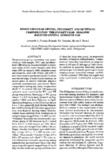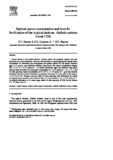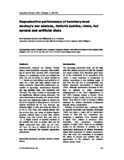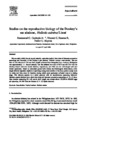Spontaneous spawning, fecundity and spawning periodicity in the donkey's ear abalone Haliotis asinina Linnaeus 1758
Share
Abstract
Spontaneous group spawning was monitored in wild-caught (WC) and hatchery-bred (HB) abalone broodstock (Haliotis asinina) held in duplicate tanks at 1:3 (male: female) ratio from June 1997 to January 1999. Abalone breeders (mean SL, wild = 69-79 mm, HB = 68-71 mm) were kept in perforated plastic baskets and fed red alga, Gracilariopsis bailinae, to excess given at weekly intervals. Abalone spawned spontaneously year-round. Water temperature during the study ranged from 26-29 degree C. A total of 139 and 128 spawning episodes were recorded for WC and HB group respectively. Spawning in WC group (mean: 7 ± 0.8) were more frequent in September (1998) and from February to April. Spawning frequency in the HB group (mean: 6.4 ± 1) was generally high during September (1998) until April. Likewise, egg production was highest during these months. Pooled mean survival from trochophore to veligers stage ranged from 7 to 30% (n=36). Potential fecundity was determined in sacrificed group of HB females (n=21) varied from 6,741-11,902 oocytes g -1 BW. Mean oocyte diameter ranged from 136 to 150 mu m. Bigger females had higher potential fecundity (range: 6.2 to 11 x 105 oocytes individual -1 than smaller females (range: 2.8 to 3.3 x 105 oocytes individual -1). The time interval between successive spawning among animals that spawned more than twice during a 5-month period ranged from 13 to 34 days for the small-size group and from 18 to 37 days for large-size group. In separately stocked HB females (without male), instantaneous fecundity was shown to range between 1,500 and 12,300 eggs g -1 BW (n=16). In contrast to potential fecundity, smaller and younger individuals gave higher 68-71 instantaneous fecundity (range: >3,000 >12,000 oocytes g -1 BW) than the bigger and older individuals (1,500-6,500 oocytes g -1 BW).
Subject
Collections
Related items
Showing items related by title, author, creator and subject.
-
Optimal sperm concentration and time for fertilization of the tropical abalone, Haliotis asinina Linné 1758
Encena, V. C., II; Capinpin, Emmanuel C., Jr.; Bayona, N.C. (Elsevier, 1998)Current interest in the tropical abalone, Haliotis asinina has generated research into seed production and culture techniques. However, there has been no report regarding the optimal sperm concentration for fertilization ... -
Reproductive performance of hatchery-bred donkey's ear abalone, Haliotis asinina, Linne, fed natural and artificial diets
Bautista-Teruel, M. N.; Millamena, O. M.; Fermin, A. C. (Blackwell Publishing, 2001)Hatchery-bred donkey's ear abalone, Haliotis asinina, Linne broodstock were given diets consisting of natural food, seaweed (SW), Gracilariopsis bailinae, D1; combination of SW and artificial diet (AD), D2; and AD alone, ... -
Studies on the reproductive biology of the Donkey's ear abalone, Haliotis asinina Linné
Capinpin, Emmanuel C., Jr.; Encena II, Vincent C.; Bayona, Nestor C. (Elsevier, 1998)The sex ratio, initial size at sexual maturity, spawning period, time interval between successive spawnings and fecundity of the Donkey's ear abalone, Haliotis asinina were studied. The sex ratio of wild abalone (>60 ...




